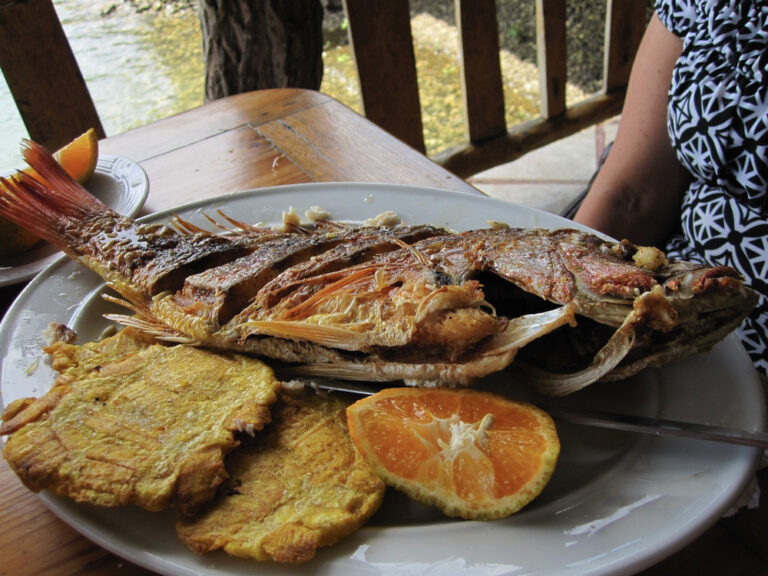Introduction: The diversity of Panamanian cuisine
Panama is a cultural melting pot, where the influences of different ethnic groups have shaped the country’s culture and cuisine. Panamanian cuisine is a fusion of Spanish, Indigenous, and Afro-Caribbean influences, resulting in a unique and flavorful culinary tradition. The country’s location, at the crossroads of the Americas, has also contributed to the diversity of its cuisine.
Panamanian cuisine is characterized by its use of fresh ingredients, such as seafood, tropical fruits, and vegetables. The country’s cuisine also reflects its history, with dishes that have been passed down from generation to generation. Today, Panamanian cuisine is celebrated for its bold flavors, hearty dishes, and diverse influences.
Spanish influence on Panamanian cuisine
Spanish cuisine has had a significant influence on Panamanian cuisine, and it is evident in many of the country’s traditional dishes. The Spanish introduced ingredients such as pork, beef, and chicken, which are now staples in Panamanian cuisine. They also brought with them spices such as saffron, paprika, and cumin, which are used in many dishes.
One of the most popular dishes in Panama is the arroz con pollo, which is a Spanish-inspired rice dish made with chicken, vegetables, and saffron. Another Spanish-influenced dish is the sancocho, which is a hearty soup made with meat, vegetables, and plantains. Spanish cuisine has also influenced the way that Panamanians prepare their food, with many dishes being cooked in a clay pot called a cazuela.
Indigenous influence on Panamanian cuisine
The Indigenous people of Panama have also had a significant influence on the country’s cuisine. They introduced ingredients such as maize, yucca, and sweet potatoes, which are still used in many dishes today. They also developed unique cooking techniques, such as using hot stones to cook their food.
One of the most popular Indigenous dishes in Panama is the hojaldre, which is a fried dough pastry stuffed with cheese or meat. Another popular dish is the tamale, which is made with masa (corn dough) and filled with meat, vegetables, or fruit. Indigenous cuisine also introduced the use of herbs and spices, such as cilantro, culantro, and achiote, which are used to flavor many Panamanian dishes.
Afro-Caribbean influence on Panamanian cuisine
The Afro-Caribbean influence on Panamanian cuisine can be traced back to the country’s history as a gateway for African slaves who were brought to the Americas. The African slaves brought with them their own culinary traditions, which have had a lasting impact on Panamanian cuisine.
One of the most popular Afro-Caribbean dishes in Panama is the rice and beans, which is a staple dish in many Caribbean countries. The dish is typically made with red beans, coconut milk, and rice, and is often served with fried plantains. Another popular dish is the rondón, which is a seafood stew made with coconut milk, yucca, and plantains. Afro-Caribbean cuisine has also introduced new spices and flavors to Panamanian cuisine, such as curry, ginger, and allspice.
Fusion cuisine: blending influences
Panamanian cuisine is a fusion of different culinary traditions, and many dishes reflect a blend of Spanish, Indigenous, and Afro-Caribbean influences. The fusion of these culinary traditions has resulted in a unique and flavorful cuisine that is celebrated around the world.
One example of fusion cuisine in Panama is the ceviche, which is a dish that originated in Peru but has been adapted to reflect Panamanian flavors. Panamanian ceviche is typically made with fresh seafood, lime juice, cilantro, and spicy peppers. Another example is the fufu, which is an African dish that has been adapted to include Indigenous and Spanish ingredients and is now a popular dish in Panama.
Conclusion: Celebrating Panamanian culinary diversity
Panamanian cuisine is a celebration of the country’s cultural diversity, with Spanish, Indigenous, and Afro-Caribbean influences all contributing to the country’s culinary traditions. From hearty stews to spicy ceviches, Panamanian cuisine is a reflection of the country’s vibrant culture and history. Today, Panamanian cuisine continues to evolve and adapt, with new flavors and ingredients being introduced to create a truly unique culinary experience.

